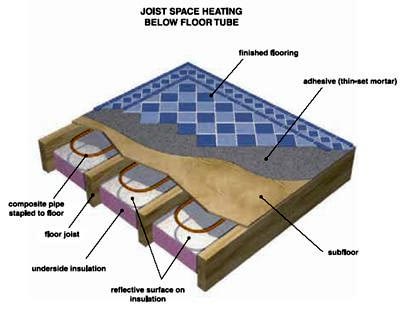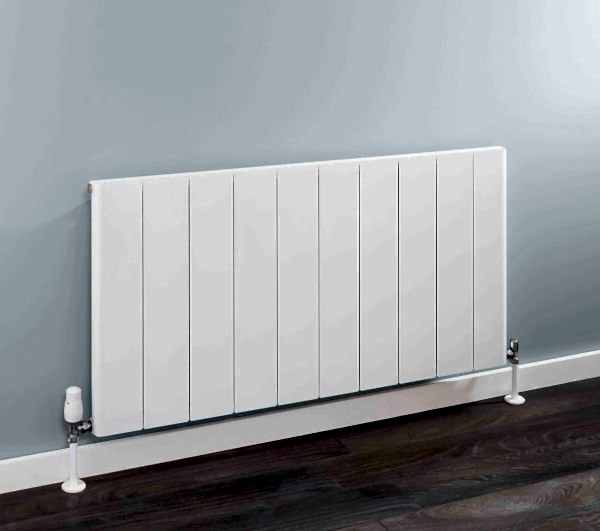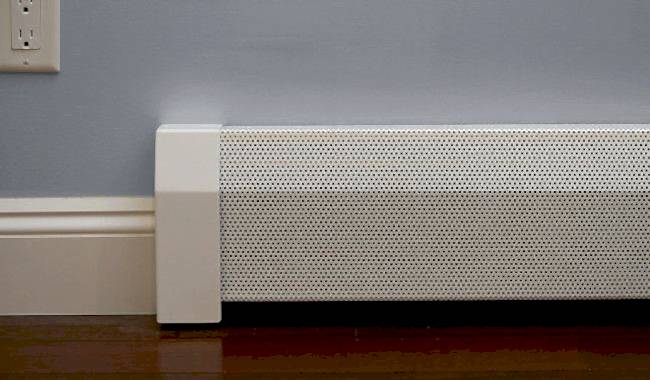Suspended Tube Radiant Heat
The ability of Pex-AL-Pex to handle relatively high water temperatures makes it possible to install a suspended tube system. The tubing is placed within the air cavity between the floor joists. The tubing gives off direct radiant energy to the surfaces within the joist cavity. The outside of the tubing also gives off heat to the surrounding air, establishing a gentle convective circulation within the joist cavities. The warm air flows across the underside of the subfloor transferring more heat to it.

Suspended tube systems have some unique benefits. They don’t require heat dispersion plates and thus reduce installation cost. They operate at high water temperatures under design load conditions and thus can often be piped directly to a boiler without needing a mixing valve. When the tubing is suspended below the subfloor, it is not subject to puncture from the nail points associated with installation of hardwood flooring. Pex-AL-Pex piping is ideal for suspended tube systems. Its aluminum core provides the structure that prevents the tubing from sagging between supports when operated with high water temperatures.
Hot Water Radiator
Hot-water radiators are one of the most common heat distribution systems in newer homes, second only to forced-air systems. They are typically a baseboard-type radiator or an upright design that resembles steam radiators. The most common problem in hot-water systems is unwanted air in the system. At the start of each heating season, while the system is running, go from radiator to radiator and open each bleed valve slightly, then close it when water starts to escape through the valve. For multi-level homes, start at the top floor and work your way down.

One way to save energy in hot-water systems is to retrofit them to provide separate zone control for different areas of large homes. Zone control is most effective when large areas of the home are not used often or are used on a different schedule than other parts of the home. A heating professional can install automatic valves on the hot-water radiators, controlled by thermostats in each zone of the house. Using programmable thermostats will allow you to automatically heat and cool off portions of your home to match your usage patterns.
Zone control works best in homes designed to operate in different heating zones, with each zone insulated from the others. In homes not designed for zone control, leaving one section at a lower temperature could cause comfort problems in adjacent rooms because they will lose heat to the cooler parts of the home. Zone control will also work best when the cooler sections of the home can be isolated from the others by closing doors. In some cases, new doors may be needed to isolate one area from another. Cooler parts of the home should be kept around 50°F to prevent water pipes from freezing. Never shut off heat entirely in an unused part of your home.

Hydronic Baseboard Heaters
Baseboard heating can be an effective and affordable solution, either for the whole house or as a supplement in rooms underserved by the main heating system.
Hydronic baseboard heaters use heated water or another liquid to control the temperature in a room or area. Positioned along the base of a wall, these heaters draw in cool air at the base, which is heated and pushed out of the top of the heater to warm the room. Low external operating temperatures allow them to be installed flush against a wall or baseboard without damaging the structure.
The technology behind hydronic heaters has been used since the 1940s and has evolved from cast iron radiators. Modern heaters of this type are lighter and easier to install than their predecessors. In a built-in system, water is piped from a central boiler to the baseboard heaters, with a return pipe channeling cooled water back to the boiler for reuse. Heaters can be separated into zones, with thermostats for each area, allowing for better control over the temperature. A range of baseboard heater covers are available to coordinate with a room’s decor without obstructing their heat.
